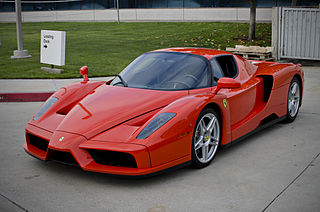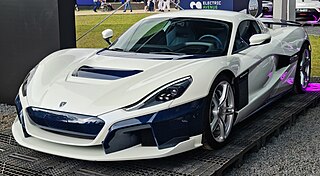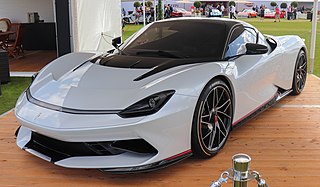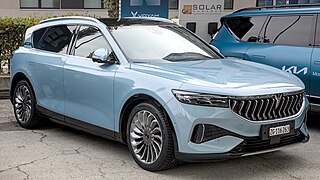
A supercar – also called exotic car – is loosely defined or described as a street-legal, luxury superlative performance sports car – both in terms of power, speed, and handling. The term 'supercar' is therefore frequently used for low-bodied sportscars with powerful, rear mid-mounted engines. Since the 2000s, the term hypercar has also come into use for the most high-end performance cars.
Power-to-weight ratio is a calculation commonly applied to engines and mobile power sources to enable the comparison of one unit or design to another. Power-to-weight ratio is a measurement of actual performance of any engine or power source. It is also used as a measurement of performance of a vehicle as a whole, with the engine's power output being divided by the weight of the vehicle, to give a metric that is independent of the vehicle's size. Power-to-weight is often quoted by manufacturers at the peak value, but the actual value may vary in use and variations will affect performance.

The Ferrari Testarossa is a 12-cylinder mid-engine sports car manufactured by Ferrari, which went into production in 1984 as the successor to the Ferrari Berlinetta Boxer. The Pininfarina-designed car was originally produced from 1984 until 1991, with two model revisions following the end of Testarossa production called the 512 TR and F512 M, which were produced from 1992 until 1996. Including revised variations, almost 10,000 cars in total were produced, making it at the time one of the most mass-produced Ferrari models.

The Ferrari Enzo, officially marketed as Enzo Ferrari, is a mid-engine sports car manufactured by Italian automobile manufacturer Ferrari and named after the company's founder, Enzo Ferrari. It was developed in 2002 using Formula One technology, such as a carbon-fibre body, F1-style automated-shift manual transmission, and carbon fibre-reinforced silicon carbide (C/SiC) ceramic composite disc brakes, as well as technologies not allowed in F1, such as active aerodynamics. The Enzo generates substantial amounts of downforce through its front underbody flaps, small adjustable rear spoiler and rear diffuser, which work in conjunction to produce 3,363 newtons (756 lbf) of downforce at 200 km/h (124 mph) and 7,602 newtons (1,709 lbf) of downforce at 300 km/h (186 mph), before decreasing to 5,738 newtons (1,290 lbf) at top speed.

The Commuter Cars Tango is a prototype ultra-narrow electric sports car designed and built by Commuter Cars, an electric car company based in Spokane, Washington.

The Alfa Romeo 33 Stradale is a mid-engine sports car built by Italian automobile manufacturer Alfa Romeo. It was the fastest commercially available car for the standing kilometer upon its introduction. 18 examples were produced between 1967 and 1969. "Stradale" is a term often used by Italian car manufacturers to indicate a street-legal version of a racing car; indeed the 33 Stradale was derived from the Tipo 33 sports prototype. Built in an attempt by Alfa Romeo to make some of its racing technology available to the public, it was also the most expensive automobile for sale to the public in 1968 at US$17,000.

The Mazda Premacy Hydrogen RE Hybrid or Mazda5 Hydrogen RE Hybrid was a hydrogen powered hybrid car produced by Mazda. Later models were also called the Mazda Hydrogen RE Plug in Hybrid. The first car was unveiled in 2005, with an improved version shown at the 2007 Tokyo Motor Show. Mazda planned for the car to enter production and leased a few cars to end users in 2009 in 2010.

The BMW i8 is a plug-in hybrid sports car developed by BMW. The i8 was part of BMW's electrified fleet and was marketed under the BMW i sub-brand. The production version of the BMW i8 was unveiled at the 2013 Frankfurt Motor Show and was released in Germany in June 2014. Deliveries to retail customers in the U.S. began in August 2014. A roadster variant was launched in May 2018. Production ended in June 2020.
The Pininfarina Sintesi is a concept car designed by Pininfarina and unveiled in 2008 at the Geneva Motor Show. The name 'Sintesi' means 'synthesis' in the Italian language.

The Porsche Taycan is a battery electric saloon and shooting brake produced by German automobile manufacturer Porsche. The concept version of the Taycan, named the Porsche Mission E, debuted at the 2015 Frankfurt Motor Show; the production Taycan was revealed at the 2019 Frankfurt Motor Show. As Porsche's first series production electric car, it is sold in several variants at different performance levels, and may spawn further derivatives in future models. More than 20,000 Taycans were delivered in 2020, its debut sale year, representing 7.4% of the total Porsche volume. A modified Taycan Turbo S is the current Formula E Safety car.

The Rimac Nevera is an all-electric sports car designed and manufactured by the Croatian automotive manufacturer Rimac Automobili. The first production prototype car was released in August 2021. Nevera production has been limited to 150 vehicles. Having completed crash testing for homologation, Rimac planned to deliver the Nevera to customers in mid-2022. The first production spec Nevera was delivered in August 2022. Deliveries to the United States started in June 2023. The Nevera is manufactured in the same factory and at the same rate as the Pininfarina Battista, which is based on the same platform.
Automobili Pininfarina GmbH is a luxury electric vehicle (EV) manufacturer headquartered in Munich, Germany, with roots in the Italian car design firm and coachbuilder Pininfarina SpA. The company also has a design facility and office locations in Turin, Italy. Its first car, the Battista hypercar, has been produced from 2021. It was introduced at the Pebble Beach Concours d'Elegance 2018, and 150 units are planned for production.

The Pininfarina Battista is an electric performance car manufactured by Automobili Pininfarina GmbH which is headquartered in Munich, Germany, with roots in the Italian car design firm and coachbuilder Pininfarina. The name Battista is a tribute to Pininfarina's founder Battista Pininfarina. The car was publicly unveiled at the 2019 Geneva Motor Show. It is the first Pininfarina-branded car.

The Ferrari SF90 Stradale is a mid-engine PHEV sports car produced by the Italian automobile manufacturer Ferrari. The car shares its name with the SF90 Formula One car with SF90 standing for the 90th anniversary of the Scuderia Ferrari racing team and "Stradale" meaning "made for the road".
RAESR is an American automobile manufacturer founded in 2014 in Los Angeles, California by Eric Rice. The company is based in Los Angeles, California and specializes in the production of electric sports cars. Their prototype model, the "Tachyon Speed", was first introduced to the public in late 2017 through an electric vehicle infrastructure series made by E.ON, one of Europe's largest energy conglomerates.

The Lotus Evija is a limited production electric sports car to be manufactured by British automobile manufacturer Lotus Cars. Unveiled in July 2019, it is the first electric vehicle to be introduced and manufactured by the company. Codenamed "Type 130" and "Omega", its production will be limited to 130 units.

The Voyah Free is a mid-size luxury crossover SUV manufactured by Dongfeng Motor Corporation and marketed by Voyah.

The Hyundai N Vision 74 is a concept car developed by Hyundai, based on the 1974 pony coupe unveiled at the Turin Auto Show in 1974. The sporty car was unveiled at N Day 2022, an event organized by the Hyundai N performance division in mid-July 2022 at Busan, South Korea, alongside the Hyundai RN22e concept based on the Hyundai Ioniq 6 electric vehicle. The N Vision 74 is a rear-wheel-drive coupe driven by two electric traction motors, both on the rear axle; power is provided by both a storage battery and a hydrogen fuel cell.

The Hyundai Vision FK is a concept car that uses a plug-in hybrid drivetrain with both a large traction battery and a hydrogen fuel cell; the concept vehicle was developed by Hyundai and Rimac Automobili. The mid-motor, rear-wheel-drive sports coupe was unveiled at the Hydrogen Wave Forum in September 2021, an event organized by Hyundai to outline its plans to popularize hydrogen vehicles by 2040 for "Everyone, Everything and Everywhere". Power is delivered through two electric traction motors, both on the rear axle. The Vision FK can be plugged in to recharge its traction battery, which has more than 60 kW-hr of energy storage capacity, and the onboard fuel cell affords it a range greater than 600 km (370 mi).
The Pininfarina B95 is an electric performance car manufactured by Automobili Pininfarina GmbH which is headquartered in Munich, Germany, with roots in the Italian car design firm and coachbuilder Pininfarina. It is scheduled to enter production in 2025.
















